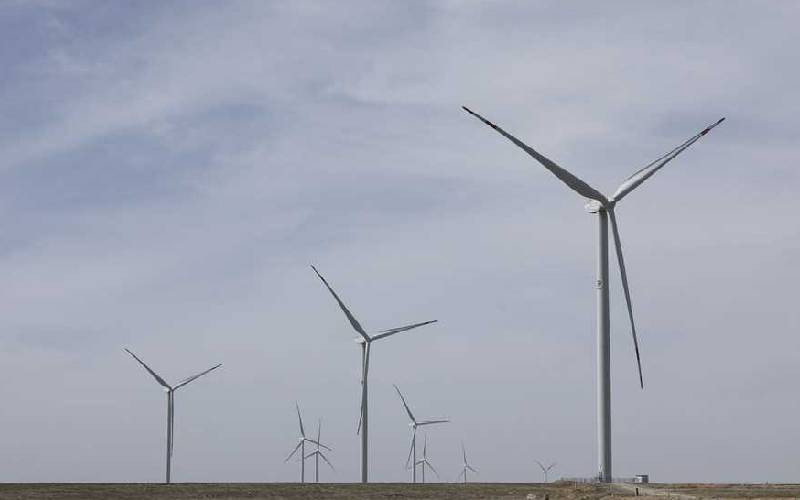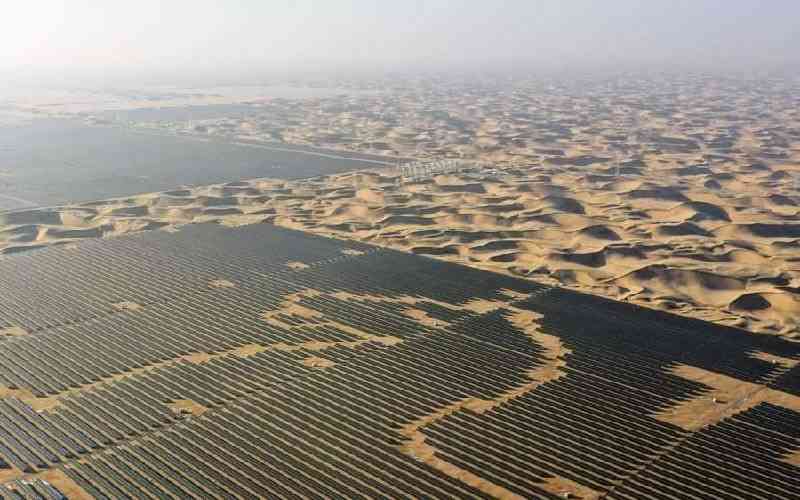
This photo taken on April 3, 2023 shows some wind turbine generators of the 100-MW Zhanatas wind farm in Zhanatas, Kazakhstan. [Xinhua]
The life of Maksat Abilgaziev, a resident of Zhanatas, a small town in southern Kazakhstan, has changed immensely since a Chinese company built a wind farm there a few years ago.
The 33-year-old was once an electrical engineer at a local phosphate mine company. Believing the future of his homeland and Kazakhstan lies in clean energy, especially wind energy, he quit the job in 2020 and became a wind power engineering trainee at the Zhanatas wind farm.
"Our Chinese friends have brought equipment, investment, technology and experience to Kazakhstan. They have also cultivated clean energy talents in our country. The wind power projects have created jobs and tax revenues for Zhanatas, bringing the town back to life," said Abilgaziev, who has been promoted to senior maintenance engineer with an income that more than doubled in three years.
This is one example of China's efforts to bolster global sustainable development over the years. The world's second-largest economy has increased its green areas at home and contributed to global sustainable growth.
PIONEERING GREEN ACTIONS
For some time, better air quality was widely expected among residents of smog-shrouded north China in winter.
Over the past decade, Chinese President Xi Jinping has led the country in an unswerving fight against pollution, rolling out effective measures, including publishing an action plan on the prevention and control of air pollution and increasing the supply of clean energy.
Air quality is crucial to the people's sense of happiness, Xi said in a discussion with national legislators from southwest China's Guizhou Province in 2014.
Today the blue skies are back, and city dwellers are breathing noticeably cleaner air. China's PM2.5 density fell 57 percent from 2013 to 2022, and its carbon dioxide emissions per unit of GDP declined 34.4 percent. The country's annual number of days with serious air pollution dropped sharply by 92 percent.
"China will prioritize ecological protection, conserve resources and use them efficiently, and pursue green and low-carbon development," Xi said at the opening session of the 20th National Congress of the Communist Party of China last year.
For years, China has placed a high value on ecological conservation, with a commitment to protecting natural resources. As a result of decades of efforts, tangible achievements have emerged in forestation, wetlands and biodiversity protection, bolstering the country's green credentials.
Take afforestation. The country has created the world's most extensive planted forest area, doubling its forest coverage rate from 12 percent in the early 1980s to 24.02 percent in 2022.
The country's afforestation area reached 960 million mu (64 million hectares) over the past decade. A 2019 finding published in Nature Sustainability showed that at least 25 percent of the foliage expansion since the early 2000s globally came from China, based on data from NASA satellites.
Thick forests have also become a substantial source of revenue for locals. Last year, the output value of China's forestry and grassland industry reached about 1.18 trillion U.S. dollars, while the foreign trade volume of forest products was 191 billion dollars.
Stay informed. Subscribe to our newsletter
Neak Chandarith, director of the Cambodia 21st Century Maritime Silk Road Research Center, hailed China as a green development leader. "The Chinese government sees green development and environmental protection as top priorities as these strategies have been integrated into all of the country's socio-economic development plans," he said.
PROMOTING GREEN INNOVATIONS
China should work to achieve greater self-reliance and strength in science and technology, promote industrial transformation and upgrading, advance coordinated urban-rural and regional development, and foster green and low-carbon economic and social development, Xi said when addressing the closing meeting of the first session of the 14th National People's Congress, the national legislature, in March.
Over the years, China has taken innovation-driven development as a driving force for economic development, helping its economy switch to green and high-quality growth. This aerial photo taken on May 25, 2023 shows birds resting in the mangrove forest near the sea in Zhanjiang City, south China's Guangdong Province. [Xinhua] 
The country is now the world's largest producer of clean energy equipment. In 2021, the output value of the energy conservation and environmental protection industry exceeded 1.13 trillion dollars.
China's export of three tech-intensive green products, namely solar batteries, lithium-ion batteries and electric vehicles, registered a 66.9 percent increase in the first quarter of this year, official data showed. Together they contributed 2 percentage points to the overall export growth, up from 1.7 percentage points for 2022.
"China's foreign trade growth in Q1 is mainly buoyed by new energy-related exports," said Zhou Maohua, an analyst with the China Everbright Bank.
According to the China Association of Automobile Manufacturers, China's new energy vehicle (NEV) sales nearly doubled to 6.89 million units in 2022, accounting for over a quarter of the total automobile sales in the world's largest auto market.
"The speed of growth here is much faster than in other regions of the world," said Oliver Blume, chairman of the Board of Management of Volkswagen AG, adding that with its high level of innovation, China is a vital pacesetter for the entire automotive industry.
In August last year, China revealed a plan for fulfilling its "dual carbon" goal of peaking carbon dioxide emissions by 2030 and achieving carbon neutrality by 2060 through technology.
China has been pursuing green development by scientific means, addressing all challenges through science, technological innovation and creativity, said Benjamin Anyagre, general secretary of the Ghana-China Friendship Association, adding that China's commitment to green development would positively impact the world's efforts to combat climate change.
This is echoed by Peter Bakker, president and CEO of the World Business Council for Sustainable Development, who said that Chinese businesses, with their enormous implementation power and creativity in areas like batteries, electric vehicles and solar power, are expected to decarbonize the world significantly.
GLOBAL ENGAGEMENT
"We should pursue the new vision of green development and a way of life and work that is green, low-carbon, circular and sustainable," Xi said at the opening ceremony of the Belt and Road Forum for International Cooperation in May 2017. "We propose the establishment of an international coalition for green development on the Belt and Road, and we will provide support to related countries in adapting to climate change."
China has walked its talk by sharing its green development philosophy globally, helping countries sustain green growth.
"Chinese involvement in Ethiopia's renewable energy sector is visible. They are increasingly involved in both hydro and wind power projects," said Moges Mekonnen, communications director at Ethiopian Electric Power, noting that the cooperation projects help Ethiopia tap into its rich renewable energy potential.
The Aysha Wind Farm, the first wind power project in the Somali region presently under the construction of China's Dongfang Electric Corporation, is expected to provide power to Ethiopia's mega-development projects, such as the Addis Ababa-Djibouti railway and Dire Dawa Industrial Park, and ensure a stable and sufficient power supply for the Addis Ababa-Djibouti economic corridor.
In the hydropower sector, cooperation with China enabled Ethiopia to realize the 254 MW Genale-Dawa III hydroelectric power station, which has been in safe operation since its launch in the first quarter of 2020. This aerial photo taken on Feb. 18, 2023 shows a photovoltaic (PV) power project in Liangzhou district of Wuwei, northwest China's Gansu Province. [Xinhua] 
In Kenya, official figures showed that the installed capacity of solar power is more than 100 MW, while the China-financed Garissa Solar power plant accounts for 50 MW.
Kenyan President Uhuru Kenyatta said that Garissa Solar, the largest solar plant in East and Central Africa, puts Kenya on the path to achieving green energy sufficiency and adds to his country's rich profile as the center of green energy generation in Africa.
While promoting green development projects, China also emphasizes maintaining biological diversity. For example, many tunnels were extended, and bridges replaced roads to protect elephant habitats during the building of the China-Laos Railway.
Philip Clayton, president of the Institute for Postmodern Development of China, a U.S. think tank, said China's contributions to greening the planet and commitments to preserving biological diversity have empowered the international community to pursue environmental reforms and more robust ecological governance.
At the same time, China is also scaling up its multilateral coordination for ecological conservation.
Last year, China's central city Wuhan hosted the 14th Meeting of the Conference of the Contracting Parties (COP14) to the Ramsar Convention on Wetlands, together with Geneva, Switzerland, which facilitated the adoption of the Global Strategic Framework for Wetland Conservation 2025-2030 that aims to curb wetland degradation.
Also, China held the presidency of COP15, known as the 15th meeting of the Conference of the Parties to the Convention on Biological Diversity. It led the parties involved to adopt a landmark deal, the Kunming-Montreal Global Biodiversity Framework, for reversing biodiversity loss.
David Cooper, acting executive secretary of the Secretariat of the Convention on Biological Diversity, commented that China's leadership role involves leading and working with parties and stakeholders to ensure an overall commitment to biodiversity.
He said China has achieved a lot in biodiversity conservation during its rapid economic growth, adding that China's active participation in combating climate change globally has the potential to provide a sound model for developing countries and contribute to consensus-building on global biodiversity conservation.